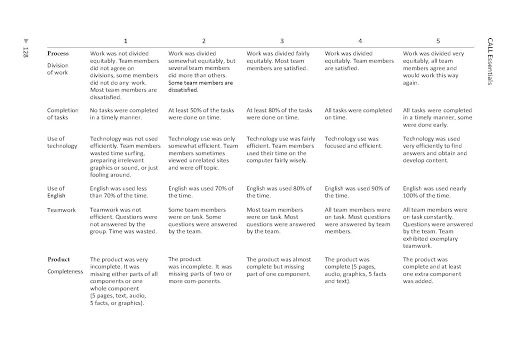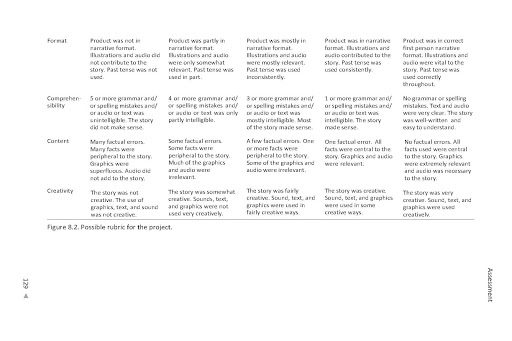Designing Rubrics for CALL Activities
Many educators find it difficult to design effective rubrics at first, but tools are available to help. For example, rubric generators, such as Quick Rubric (https://www.quickrubric.com/) and Rubric Maker (https://rubric-maker.com/), format the information quickly and easily. Whether teachers use a rubric generator or type their rubric in a word processing program, the decision steps are the same and teachers (and /or students) must supply the rubric’s content. Following these general steps can help teachers to ensure a successful assessment process:
- Review goals and objectives for the project or task.
- Think about what an efficient and effective process would look like and how it meets the goals of the task. Think about what an excellent finished product would look like (and how it would meet the goals). Note what aspects of the goals that the process and the product meet and how they do so.
- Decide on major categories for assessment. Check these against the goals and the finished project description to make sure that you have not left out any important categories.
- Develop subcategories as needed. For example, if one of your categories is “uses technology appropriately,” you might want to include a subcategory dealing with ethical use.
- Divide your scale appropriately. Thinking of descriptions for more than five numbers takes a great deal of time and effort, so many rubrics have multiple point options for each criteria within a category (e.g., 1–2, 3–4, 5–6) or a simple five-point scale for each category. It is important that students know the relative importance or weight of all of the subcategories.
- Develop precise descriptions for each ranking in your scale. The use of quantifiable elements helps students understand minimums for each level. If you use words like kind of, rarely, and so on, give examples of how the scoring of each ranking looks in practice.
- Review the rubric according to the guidelines outlined previously. For example, ask yourself, “Is the assessment authentic? Learner centered? Integrated into classroom activity? Does it take place in multiple contexts, assess both process and outcomes, fit the content and method of what is taught, and encourage students to reflect and learn consciously?” If the rubric does not meet these goals, revise or choose another form of assessment.
- Use the rubric.
- Revise the rubric after using it. Teachers can also revise in progress if it becomes clear that the rubric is not fair or that something has been left out. Just be sure the students know what the changes are and why they were made.
A rubric for Ms. Hagerty’s project in the opening scenario could take many different forms. The following is one example of how she might complete each of the steps.
► Project: Historical Book
Goals and objectives: Work with teammates effectively, distinguish fact from fiction, learn historical facts, use past tense, practice narrative format, produce error-free text (grammar and spelling), follow instructions, meet standards in social studies and ESL.
Process, product: An effective process has students working together to find answers to questions, dividing work so everyone does an equitable (not necessarily equal) share, completing tasks on time, using technology efficiently, and working in English as much as possible. An excellent product would be creative, well illustrated, free of grammatical errors, factually correct, in narrative format, and complete; have clear audio; and share important historical information about the figure.
Major categories: process, product
Subcategories: Process: division of work, completion of tasks, use of technology, use of English, teamwork. Product: completeness, format, content, creativity, comprehensibility.
Scale divisions: 1–5 for each subcategory (total of 50 points)
Descriptions: General levels are 1 = does not meet the goal, 2 = somewhat meets the goal, 3 = almost meets the goal, 4 = clearly meets the goal, 5 = exceeds the goal
A finished rubric for the project could look something like Figure 8.2.
Rubrics do not stand alone in classrooms. Ms. Hagerty will review this rubric with her students several times, answering questions about the evaluation (including explaining any terms that they do not understand), updating students on their team’s progress according to the rubric as she observes their work, and using the rubric as a framework through which to discuss the project.


Feedback/Errata